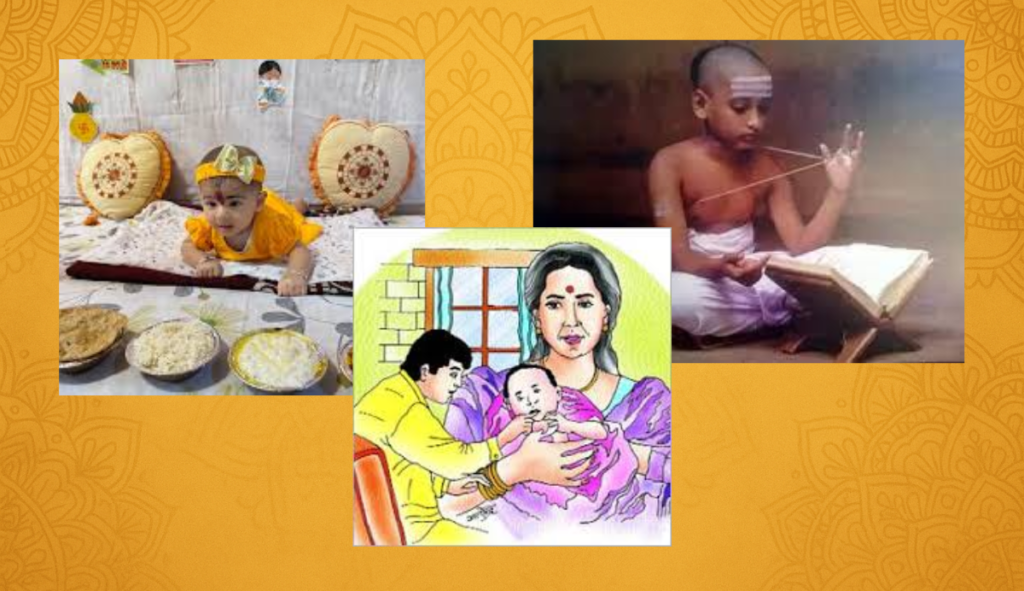Sanatan Dharma is a holistic life philosophy, not confined merely to rituals and worship, but one that sanctifies every stage of human life. To ensure this divinity, the Vedic sages conceptualized 16 sacred rites — known as the Shodasha Samskaras. These rites are a systematic process to make an individual physically, mentally, socially, and spiritually refined.
In ancient Vedic culture, these samskaras were considered essential, as they help elevate a person from a state of 'animal instincts' to 'human consciousness', and finally towards 'divinity'. Let us now understand each samskara in sequence:
Garbhadhana Sanskar
This is the first rite performed after entering married life. Its aim is to conceive a child with pure intent and consciousness. Both partners engage in spiritual and mental purification, praying for a virtuous and healthy progeny.
Pumsavana Sanskar
Performed during the 3rd or 4th month of pregnancy, this samskara aims to ensure the health, intellect, and protection of the fetus. Traditionally associated with desiring a male child, its modern relevance lies in nurturing mental well-being and spiritual growth.
Simantonnayana Sanskar
This rite is performed in the 7th month of pregnancy for the mental peace and emotional care of the expecting mother. Considered the Vedic version of a ‘baby shower’, it includes parting the mother's hair and offering her respect and blessings.
Jatakarma Sanskar
Performed immediately after birth, this sanskar involves placing honey and ghee on the infant's tongue while chanting mantras. The father whispers the baby’s name in the right ear — symbolizing spiritual awakening and blessings.
Namakarana Sanskar
Held on the 11th or 12th day after birth, this samskara gives the child a name based on astrology, nakshatra, or family tradition. A name is not just identity, but a vibration that shapes personality and destiny.
Nishkramana Sanskar
When the baby is 4 months old, they are brought outside the house for the first time to view the sun and moon. This connects the child with nature and the universe, marking the beginning of engagement with the outer world.
Annaprashana Sanskar
Performed in the 6th month, this rite introduces the child to solid food — usually rice or kheer. Along with nourishment, it invokes family blessings and divine protection for health and vitality.
Chudakarana Sanskar
Also known as the ‘mundan’, this samskara involves shaving the child’s hair between 1 to 3 years of age. It is believed to remove past life impurities and stimulate mental development.
Karnavedha Sanskar
This rite involves ear-piercing of the child. It activates specific nerves which, according to Ayurveda and spiritual belief, enhance memory, concentration, and immunity.
Vidyarambha Sanskar
This samskara marks the beginning of formal education. The child writes ‘ॐ’ or ‘A’ for the first time and prays to Goddess Saraswati, symbolizing the initiation into the journey of knowledge.
Upanayana Sanskar
Also called the 'sacred thread' ceremony, this samskara signifies the start of Brahmacharya ashram. The child is initiated into Vedic learning, self-discipline, and service under a Guru’s guidance — marking spiritual entry.
Vedarambha Sanskar
Performed after Upanayana, the child formally begins the study of Vedas and scriptures. It symbolizes not just knowledge acquisition, but the inner journey of self-awareness and discipline.
Keshanta Sanskar
Done during adolescence, this samskara involves shaving facial hair for the first time. It marks physical maturity and growing social responsibilities. Sometimes associated with the ritual of 'godaan' (donating a cow).
Samavartana Sanskar
This rite concludes formal Gurukul education. The student offers Guru Dakshina and prepares to enter household life. It symbolizes the transition from knowledge to action in worldly life.
Vivaha Sanskar
This is the entry into the Grihastha Ashram. The bride and groom take seven vows (Saptapadi) before the sacred fire, committing to love, support, and dharmic partnership. It is the sacred union of two souls.
Antyeshti Sanskar
This final rite is performed after death. The body is returned to the five elements through cremation. Rituals like pind daan and tarpana are done to ensure peace and liberation of the soul.
The Shodasha Samskaras represent the completeness of life in Sanatan Dharma. They are not mere rituals, but progressive stages of human refinement — physical, mental, intellectual, and spiritual. When understood deeply and practiced sincerely, they make life a true path of tapasya, dharma, and liberation.
